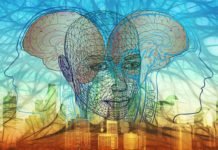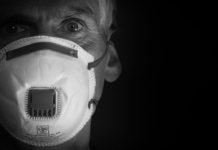The covid-19 WHO is known as a global crisis as a global epidemic. Covid-19 has claimed human lives and the social and economic imbalanced of the country. It has also been shown to change the interpretation of many interdisciplinary concepts related to science. Psychologists will have today faced the challenge of reconstructing theories and thought streams. As a result, the interpretation of the biological causal factors of psychopathology and abnormal behavior also appear to have changed. Due to coronavirus number of human persons are facing the psychological relate as a behavioural consequences. APA and WHO has agreed to microorganisms (Covid-19) Covid-19 will have to be placed as the causal factor in the pathology of malformation. Coronavirus has been shown to cause significant negative changes in the behavior of the general population. It is clear that the coronavirus has also been recognized by the WHO as the root cause of various mental illness. Present reviewed based article shows to covid-19 related mental illness in briefly.
Social distancing, shelter-in-place orders, restaurant closures-the world we currently live in has become a very strange and turbulent place. Coronavirus has transformed everything we thought we knew about our daily lives, our government, and our health into a kind of bizarro world where Face time dating and panic-buying toilet paper are the new norm. It’s taking a toll on even the most optimistic of us as we try to stay positive amidst what feels like bleaker and bleaker news each day. Now, imagine how this already unsettling situation feels for the millions peoples with mental illness.
Those suffering from anxiety, depression, PTS, substance abuse, and other forms of chronic mental illness are some of the most vulnerable right now in terms of loneliness, isolation, and potential for self-destructive behavior due to a lack of consistent support and a disrupted routine.
In an effort to help those with mental illness (and their friends and loved ones who may be concerned about the impacts COVID-19 may be having on them), we spoke to the experts on the specific challenges those with the most common conditions face, as well as what actions they can practice and networks they can access to remain healthy and safe.
About COVID-19
For something that’s messing so severely with pretty much every aspect of our day-to-day, there are still a lot of questions and misconceptions surrounding coronavirus. Before we dive into the specific toll it is taking on mental illness, here are a few key facts we all need to know about the global pandemic.
Coronavirus presents as an upper respiratory illness with symptoms similar to pneumonia. You can become symptomatic anywhere from two to fourteen days after exposure. It is a highly contagious disease that can be spread from person-to-person contact, respiratory droplets that are released in the air when someone infected coughs or sneezes, and possibly by touching a surface or object with the virus on it and then touching your mouth, nose, or eyes.
| Symptoms | % of case | Facts |
| Fever | 88 | This is a major symptom. A temp of 101 or above is cause for concern |
| Cough | 67 | A dry persistent or wetter cough with a soupy sound |
| Short of Breath | 18 | This applies to becoming easily winded while doing everyday activities |
| Fatigue | 38 | Deep exhaustion that can hit during the flu |
| Sputum production | 33 | This is a mix of saliva and mucus that’s coughed up from the respiratory tract |
| Sore throat | 14 | Typical sore throat pain like experience with a cold |
| Joint Pain | 14.8 | Aches and pains in our joints that are similar to flu |
| Headaches | 13 | A typical headache- head just hurts and it hurts bad |
SARS-CoV-2 (and the illness it causes, COVID-19, commonly referred to as coronavirus), is a new type of virus that scientists believe started in December 2019 in the Wuhan province of China and has since spread to every continent and worldwide.
Significance between Coronavirus and Mental illness
Nearly half of Americans (48%) are anxious about the possibility of getting coronavirus, COVID-19, and nearly four in ten Americans (40%) are anxious about becoming seriously ill or dying from coronavirus, but far more Americans (62%) are anxious about the possibility of family and loved ones getting coronavirus. This is according to a new national poll released today by the American Psychiatric Association (APA). More than one-third of Americans (36%) say coronavirus is having a serious impact on their mental health and most (59%) feel coronavirus is having a serious impact on their day-to-day lives. Most adults are concerned that the coronavirus will have a serious negative impact on their finances (57%) and almost half are worried about running out of food, medicine, and/or supplies. Two-thirds of Americans (68%) fear that the coronavirus will have a long-lasting impact on the economy. Most Americans (68%) feel knowledgeable about coronavirus and preventing its spread. Americans are evenly split on whether people are overreacting or being overly cautious when it comes to coronavirus. About four in ten adults (39%) feel people are overreacting and nearly the same number do not feel that people are overreacting. Just roughly 21% are uncertain. About one in three adults is concerned about not being able to access tests and health care if needed. Most people report that, despite the high levels of anxiety resulting from coronavirus, they have not yet felt significant behavioral impacts. Only 19% report having trouble sleeping, 8% have been consuming more alcohol or other drugs/substances, and 12% say they have been fighting more with partner or loved ones (because of being stuck at home together). Slightly more, nearly one in four people (24%), say they have had trouble concentrating on other things because they are thinking about coronavirus.
Common Psychological reactions to Covid-19:-
Covid-19 has changed the definition and nature of mental illness and abnormality. Recent following signs and symptoms were observed in coronavirus affected persons. In below highlighting few reactions:
- Concern about protecting oneself, from the virus because they are at higher risk of serious illness.
- Feeling socially isolated, especially if they live alone or are in a community setting that is not allowing visitors because of the outbreak.
- Guilt, if loved ones help them with activities of daily living.
- Increased levels of distress if they: i) Have mental health concerns before the outbreak, such as depression. ii) Live in lower-income households or have language barriers iii) Experience stigma because of age, race or ethnicity, disability, or perceived likelihood of spreading virus.
- Mixed emotions, including relief after quarantine
- Fear and worry about your own health and the health of your loved ones
- Stress from the experience of monitoring yourself or being monitored by others for signs and symptoms of covid-19
- Sadness, anger, or frustration because friends or loved ones have unfounded fears of contracting the disease from contact with you, even though you have been determined not to be contagious
- Guilt was creating towards about not being able to perform normal work or parenting duties during quarantine.
- Other emotional or mental health changes seem in various cases.
Is Covid-19 a New perspective of Mental disorders
Every human beings and responsible assets feel nervous or scared; multiply that by 1000 and we begin to understand how this situation feels to those suffering from mood and personality disorders. The effects of this crisis are more far-reaching than heightened anxiety, which pretty much everyone is feeling. There are also trickle-down effects to those with addiction and behavioral disorders like OCD, ADHD, and substance abuse. Along with the good that social distancing can do for our own health and society in general, it also increases feelings of isolation, loneliness, stress, and fear—all of which can be triggers that make many mental illnesses infinitely worse. There are specific concerns and challenges with the coronavirus pandemic for each of the nine most common mental health conditions. While some overlap, many are a bit more specific.
I) Anxiety Disorder
While there are many specific types of anxiety, one of the most common is Generalized Anxiety disorder (GAD, which affects more than 6 million Americans. While it is normal to worry, those diagnosed with GAD have difficulty controlling worry on more days than not for a period of over six months and have three or more common symptoms: having a persistent sense of impending doom or danger, being irritable and on-edge, rapid breathing, constant trembling, feeling weak or tired, having difficulty concentrating or trouble sleeping, and having an increased heart rate.
For these people, the COVID-19 pandemic may create an elevated fear of catching or dying from the virus. Anxiety sufferers are prone to catastrophizing, which can result in behaviors like panic buying or trying different medications and treatments in an effort to “cure” or prevent coronavirus. (For the record, WHO and the CDC both state that there is currently no known cure or proven medication for COVID-19.) They can also fall victim to compulsively checking the news, scrolling and scrolling for something more definitive that just won’t come. On the positive side, those who have been in treatment for an anxiety disorder might actually be better prepared for the current situation as they already have some coping mechanisms in place to deal with their day-to-day fears. But, for some, this could also be a tipping point that makes them paralyzed by that fear.
Which is why experts stress that one of the most important things those with anxiety must do right now is to recognize that there is no such thing as having no fear. At some point or another, we all will be afraid of something. How we respond to that fear is what will determine how we get through this crisis.
II) Depression Disorder
All have bouts of sadness from time to time, for the 17.7 million people diagnosed with clinical depression, that grief and sadness is constant and comes with other symptoms like exhaustion, trouble sleeping, a shrinking appetite and/or overeating, sudden crying spells, and sometimes thoughts of suicide. Just as with anxiety, the fear and isolation can be very dangerous for those with depression, because without an outside influence to remind them of the good, they may instead focus solely on the bad news and develop a skewed sense of the situation, and potentially not be able to pull themselves out of that spiral. Depression sufferers may have a growing sense of hopelessness or be paralyzed by their fear, leading them to neglect themselves and their health. Loneliness and fear can also be triggers for suicidal thoughts.
III) Obsessive compulsive disorder
Obsessive compulsive disorder is a type of anxiety disorder that happens when a person gets stuck in a cycle of obsessions and compulsions. Obsessions are considered any thoughts, images, or impulses that recur frequently and feel outside of your control to stop or manage. Compulsions are repetitive physical behaviors or thoughts that someone might use in an attempt to make their obsession go away. Most people with OCD are able to recognize that their compulsions will not make obsessions go away, but fall victim to them as they appear to be the only way they can cope or escape.
For those with OCD, specifically those whose obsessions and compulsions that revolve around cleanliness and germs, a global pandemic is their worst nightmare come to life. The CDC recommends hand washing and home sanitizing “frequently,” but that can be taken to the extreme by those with OCD. Instead of washing their hands for 20 seconds every time they’ve been outside or coughed and sneezed, they may find themselves scrubbing their hands raw under scalding hot water for 20 minutes in an effort to feel “clean.” Stress around the virus can also trigger compulsions around counting or checking things, according to our panel.
IV) Substance Abuse Disorder
An all-too-common disorder that affects a wide spectrum of age, race, and socio-economic groups, substance abuse disorder is a disease that affects the brain and behavioral patterns, causing a person to be unable to control their use of addictive substances like alcohol, tobacco, illegal drugs, and prescription medication. Many people with a substance abuse problem also suffer from another form of mental illness over 9 million adults.
The big concern for those in treatment for substance abuse is the risk of relapse. Many of those in treatment for substance abuse rely on daily meetings or support groups like Alcoholics Anonymous. As experts note, while addiction is treatable, no one can recover alone. With isolation and lockdowns in place, many people aren’t able to get the support they need to help battle their urges.
V) Eating Disorders
There are three main types of eating disorders: anorexia nervosa, bulimia nervosa, and binge-eating disorder. People with anorexia tend to be obsessed with their weight, drastically restricting their calorie intake and extreme amounts of exercising, constantly thinking they are overweight even when they are in fact dangerously underweight. For those with bulimia, their disorder is typified by periods of uncontrollable binge eating, followed by a sensation of being painfully full and the need to “purge” in an attempt to compensate or get rid of the calories they now feel guilty for consuming.
Binge-eaters will also experience that same urge to eat and inability to control how much they eat, but they do not practice purging or calorie restrictions post-binge. For those with eating disorders, the main concern is around the perceived fear of lack of supplies. Those with an eating disorder may believe they need to hoard food; due to the consistently empty shelves they see at the grocery store. They may also find a reason to use these non-existent food shortages as an excuse to deprive themselves of food as a form of rationing.
VI) Attention-deficit/hyperactivity disorder
Attention-deficit/hyperactivity disorder (ADHD) is a behavioral disorder that causes someone to suffer from inattention and difficulty focusing, along with hyperactivity, fidgeting, and impulse control issues. While most people relate ADHD to children, many adults also suffer from ADHD, which can lead to major disruptions in their daily life. This can include everything from work performance to relationships.
One of the main problems for those with ADHD who are stuck at home during the COVID-19 outbreak is a severe decline in productivity. With most people working from home and many companies having to lay off percentages of their workforce, now is not the time to look as if you are slacking on the job. Another concern from experts have is that, due to their inability to focus or stay on task, some patients with ADHD may not be able to follow the strict guidelines for protecting you and your loved ones against the spread of infection. ADHD patients may forget to wash their hands frequently or find it hard to stay inside.
VII) Post Traumatic Stress Disorder
For anyone who has been exposed to a type of trauma, post-traumatic stress is a common condition that can occur. It is most typically associated with military veterans, but is also something that can happen after traumatic events that range from car crashes and natural disasters to sexual abuse survivors. Symptoms of PTS include reliving the event (flashbacks), nightmares, avoiding certain places or activities that remind you of the trauma, paranoia, isolation, and hyperawareness.
Conclusion
The mental illness caused by the pandemic can and is having an effect on people’s physical and mental illness.
Reference
- American Psychiatric Association-sponsored poll conducted online via a Porter Novelli PN View: 360 survey using Engine’s online CARAVAN® Omnibus survey.
- Briefing note on addressing mental health and psychosocial aspects of COVID-19: https://interagencystandingcommittee.org/other/interim-briefing-note-addressing-mental-health-andpsychosocial- aspects-covid-19-outbreak
- Brooks, SK et al. The psychological impact of quarantine and how to reduce it: rapid review of the evidence. The Lancet. Published online February 26, 2020. https://www.thelancet.com/journals/lancet/article/PIIS0140-6736(20)30460-8
- Center for the Study of Traumatic Stress (CSTS): https://www.cstsonline.org/resources/resource-master-list/coronavirus-and-emerging-infectious-disease-outbreaks-response
- Centers for Disease Control and Prevention (CDC) Crisis and Emergency Risk Communication (CERC) Manual: https://emergency.cdc.gov/cerc/manual/index.asp
- Centers for Disease Control and Prevention: U.S. Department of Health & Human Services. APA CEO and Medical Director Saul Levin, M.D., M.P.A. America.
- Diagnostic and statistical manual of mental disorders : DSM-5 ™, th ed, 2013.https://www.psych.org.
- Managing Children’s Fear, Anxiety in the Age of COVID-19 – Medscape – Mar 11, 2020.
- National Center for Immunization and Respiratory Diseases (NCIRD), Division of Viral Diseases
- Report of Centers for Disease Control and Prevention April 2020: www.cdc.gov https://www.cdc.gov/childrenindisasters/index.html
- Report on Coping with stress during infectious disease outbreaks, April 2020: https://www.disasterdistress.samhsa.gov
- Report on Coronavirus Is Affecting the Mental Health: https://www.psycom.net/coronavirus-mental-health.

























